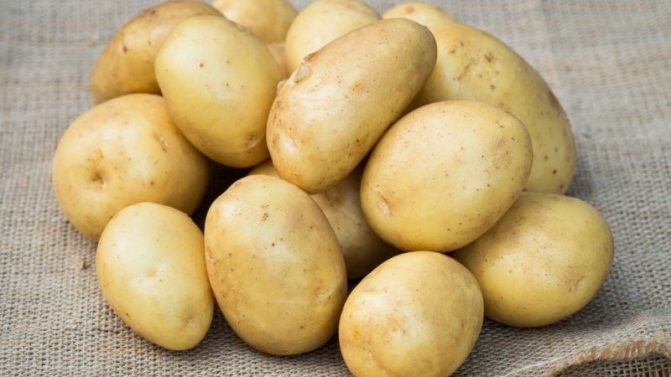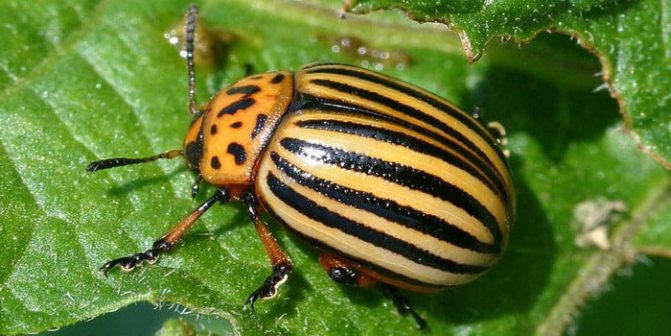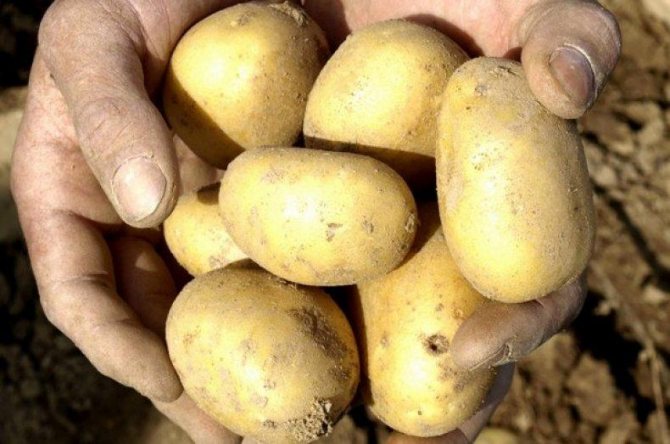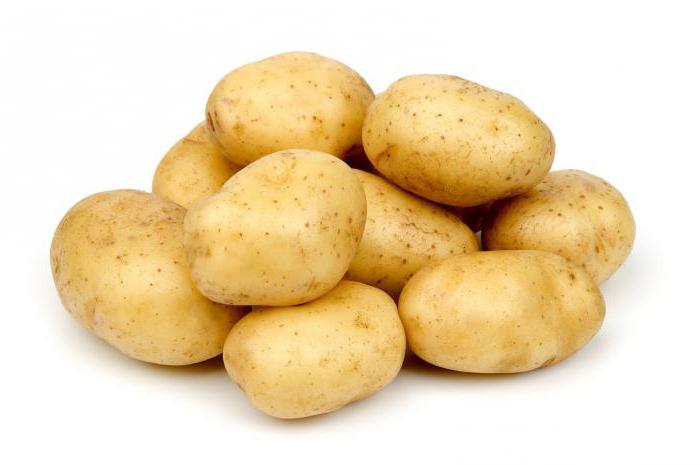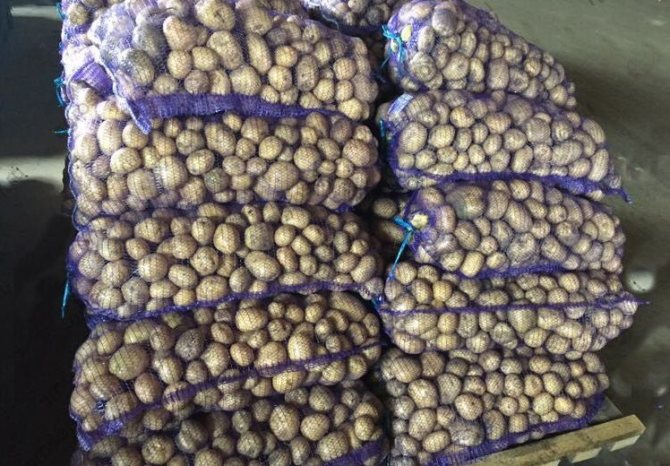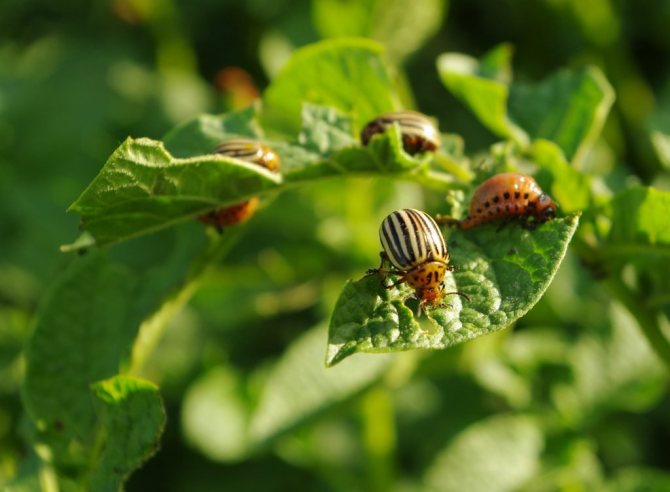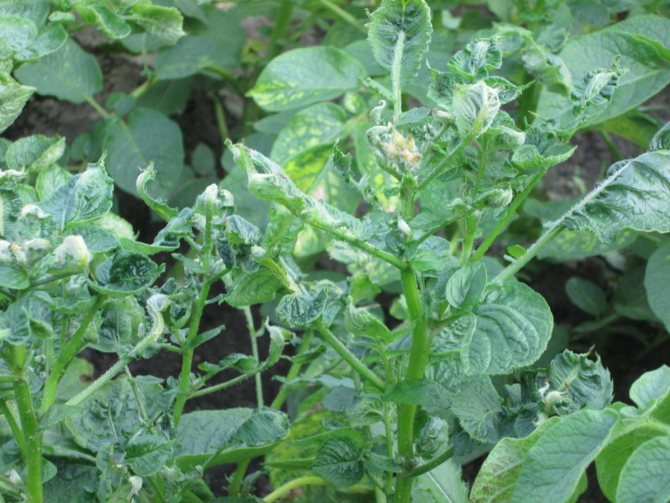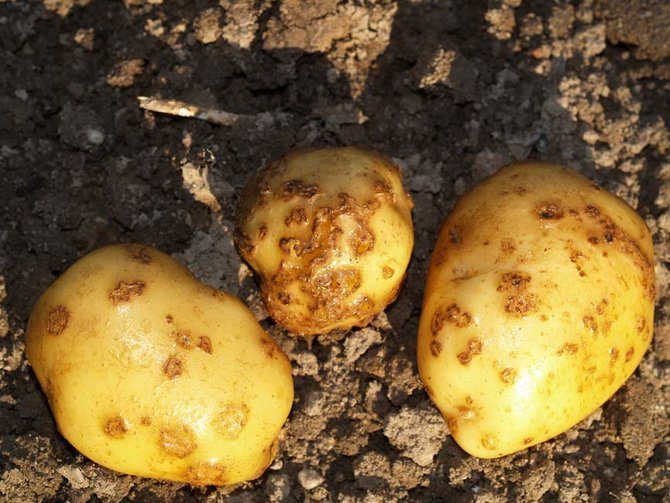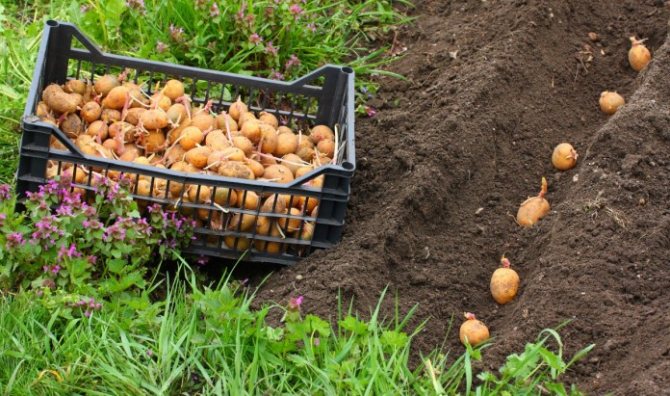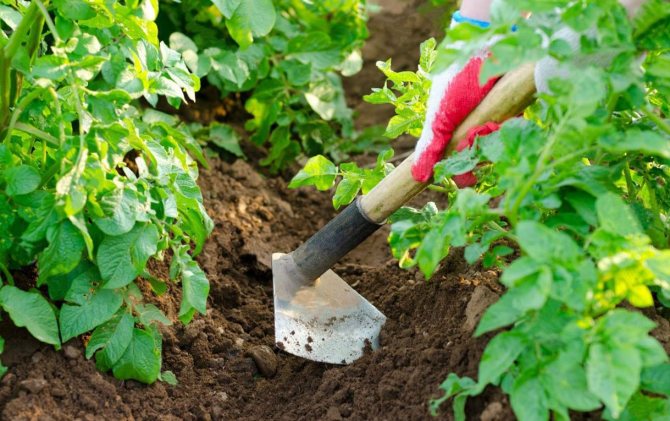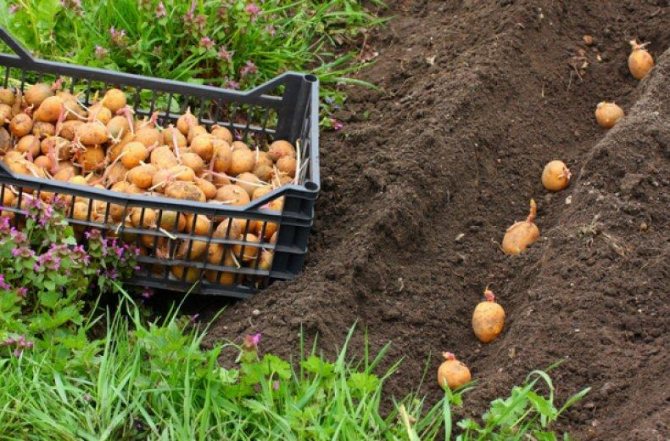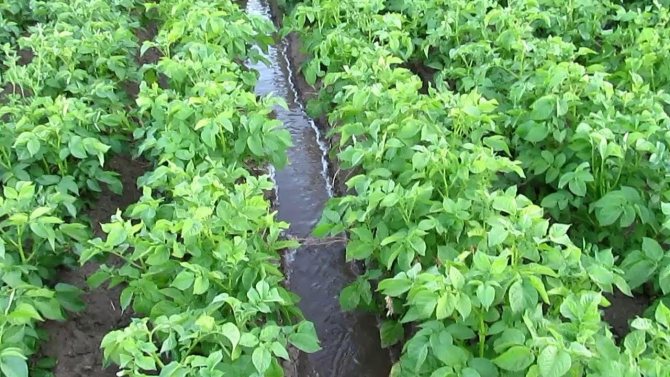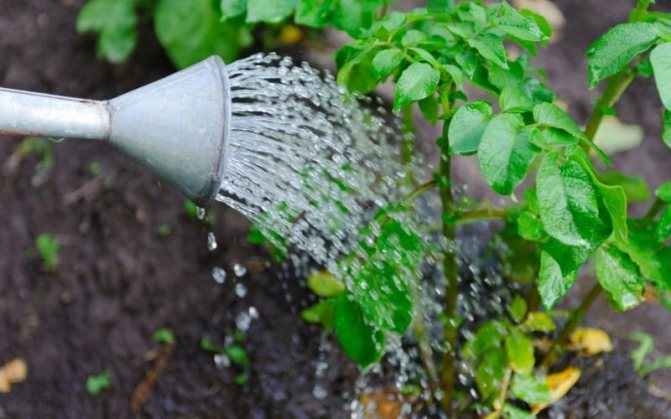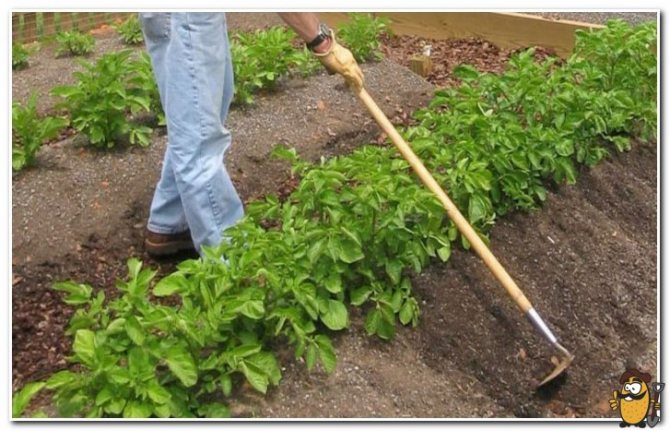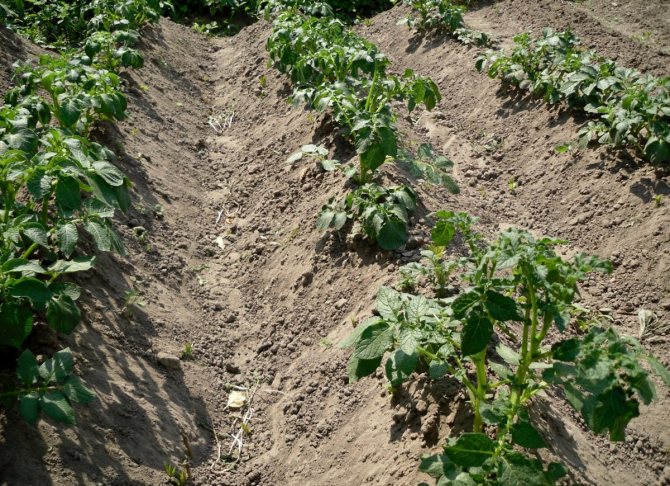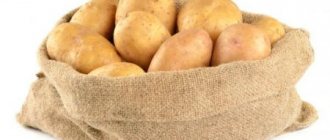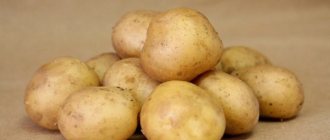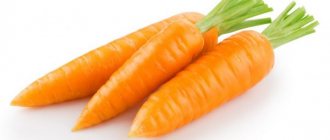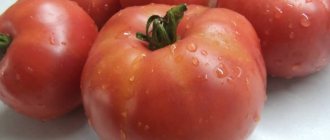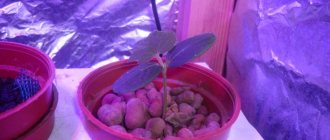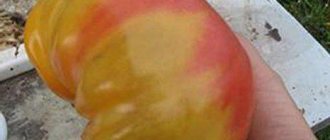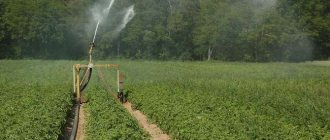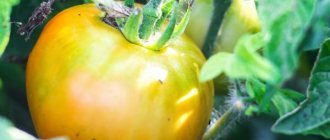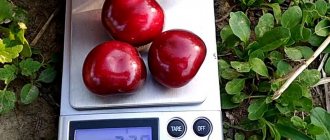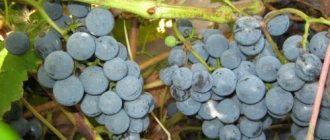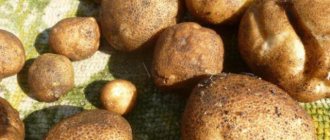Uladar has a high yield. After planting one tuber, up to 11-14 potatoes are removed from the bush. The taste of the culture is excellent. It is a versatile variety that can be used to prepare any kind of food. Potatoes are boiled, fried, stewed, chips are made.
Potatoes have good keeping quality. After harvesting, the roots are stored until spring. At the same time, they do not deform, do not germinate, do not change their taste characteristics.
Root crops have a pleasant yellow color. There are practically no eyes. The surface of the tubers is smooth and even. The pulp is creamy. During heat treatment, it becomes more yellow. The shape is round, but oblong specimens can be found. The mass of one potato ranges from 150 grams. Subject to all agrotechnical measures, potatoes can weigh up to 200 grams.
Characteristic
Uladar potato tubers develop intensively and gain weight. The first sample of tubers is possible already on the 45th day of growth. In industrial cultivation at this stage of ripeness, young tubers show a yield of 70 to 160 c / ha. During harvesting, the shaft rises to 600 c / ha. The maximum collection rate in the central regions of Russia is 425 c / ha, in Belarus - 716 c / ha.
Tubers of the Uladar variety have distinctive commercial properties: attractive presentation, uniformity, transportability, resistance to mechanical damage, good taste, keeping quality up to 94%. According to reviews, the tubers of the Uladar variety are characterized by density. Potatoes do not boil over, the flesh does not darken, suitable for making chips, fried dishes and salads.
Growing features
Considering the early ripening period of Uladar potatoes, 50-65 days, two harvests of this variety are obtained in the southern regions. It develops well on different soils, although it is preferable to plant the early ripening variety on loose fertile soils. The Uladar variety belongs to drought-resistant plants, only with a prolonged absence of precipitation does it need moderate watering. Since the tubers grow rapidly, the plant actively absorbs nutrients from the soil. According to the author's characteristic of Uladar, potatoes belong to the 1st class of plants in terms of the degree of removal of nutrients from the soil. Providing enough of them for maximum development of tubers is the main task of vegetable growers.
Uladar resists potato crayfish, wrinkled and banded mosaics, scab and dry fusarium rot. The variety is resistant to damage by the golden nematode. Uladar potatoes are characterized by an average susceptibility of tops and tubers to late blight, Alternaria and leaf-rolling virus. Potatoes are susceptible to rhizoctonia disease, as well as attacks by Colorado beetles.
Comment! Following the peculiarities of the Uladar potato variety, vegetable growers regularly feed and water the plantings in the dry season.
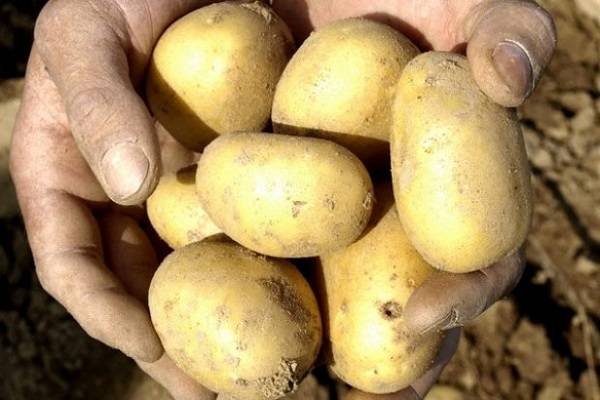
Yield
"Uladar" has gained its popularity due to its high yield. The first young potatoes can be harvested in mid-June in sufficient quantities. This is more than a kilogram per bush and from 16 to 35 tons per hectare.
Ripe potatoes are harvested just over three months after sowing.The average harvest of potatoes per hectare ranges from 40 to 55 tons.
The record for potato yields per hectare was more than seventy tons. In the southern regions, it is not uncommon for the crop to be harvested twice a year.
This adds to the popularity of the variety, which is distinguished by excellent productivity, unpretentious care and resistance to diseases and pests. Its excellent taste makes it a welcome dish on any table.
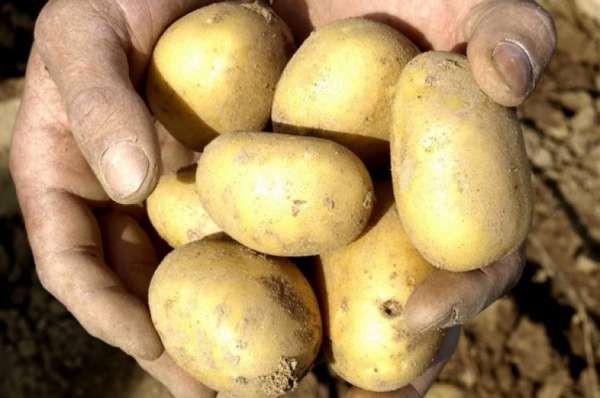

Description
The bush of the potato cultivar Uladar is semi-erect, intensively developing, grows up to 60-65 cm. Leaves are medium-sized, slightly wavy at the edges. The flowers are light purple or more intense in color. Sometimes fruits are formed. There are 8-12 medium and large, usually uniform tubers in the nest. Light sprouts of potatoes from below are slightly pubescent, red-violet.
Rounded-oval, less often oblong tubers of the Uladar potato variety with small superficial eyes, average weight from 90 to 140 g. The maximum recorded weight is 180 g. Smooth yellow peel. The pulp is creamy yellow, firm. In the process of culinary processing, it acquires a richer shade. The starch composition is 12-18%. Tasters rate the taste of Uladar tubers at 4.2 points.
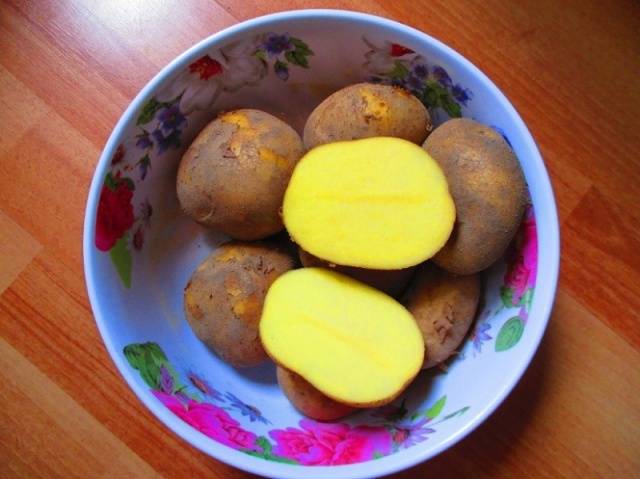

History of appearance in Belarusian breeding
The work on the selection of the variety was carried out by a number of scientists, including:
- I. Kolyadka;
- L. Vologdina;
- V. Makhanko;
- G. Piskun.
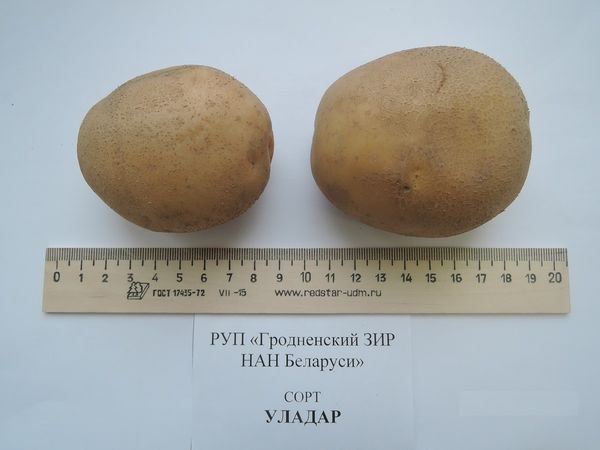

Belarusian scientists worked on the selection of the Uladar variety
It was to them that the authorship was assigned. It should be noted that Uladar is a fairly young variety, because it was only in 2008 that it was included in the State Register and recommended for cultivation in the Central Region. During this time, he managed to win the hearts of not only Belarusians, but also get far beyond the borders of the republic.
Advantages and disadvantages
Judging by the popularity and speed of distribution of the Uladar potato variety, it is preferred by many professional potato growers, as well as owners of summer cottages and backyards:
- Early;
- High-yielding;
- Good commercial properties;
- Excellent raw materials for delicious dishes;
- Resistant to a number of diseases.
The disadvantages of the Uladar potato variety are not so pronounced and consist in the observance of intensive technologies when growing:
- Mandatory fertilizers;
- Treatment with strong insecticides against Colorado potato beetles;
- The need for watering during a prolonged drought.
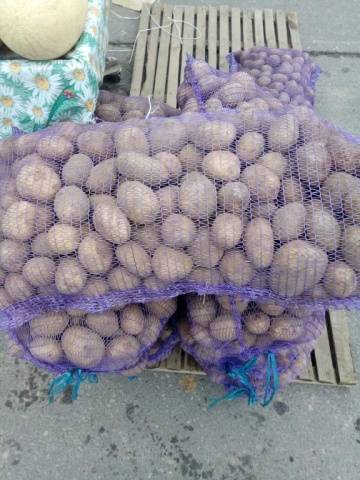

Testimonials
“We have been looking closely at Uladar potatoes for two seasons. Observed a neighbor using different planting methods. This variety is able to take root with any of them. The potatoes are delicious, we store them in the cellar, we sort them out infrequently, we use them until early spring. Recommended for landing, we put pluses ", - Nikolay and Tatiana Sokolov, Torzhok
“I consider Uladar potatoes to be one of the best on the market. True, the mashed potatoes from it are not attractive, gray in color, and not so tasty. We fry it, put it in soup. Marketable tubers, stored until spring ", - Ivan Chistov, Myshkin.
Agrotechnics
A month before planting, seed potato tubers are sorted out, rejecting them with noticeable damage. Healthy planting material of Uladar potatoes is laid out in boxes in 2-3 layers for germination and placed in a bright room. At temperatures above 14-15 ° C, early potato vernalization begins - light sprouts appear. Directly on the day of planting, some farmers process the sprouted tubers with drugs against Colorado beetles: Prestige, Commander, and growth stimulants: Zircon, Mival, Gibbersib. Spraying is carried out in accordance with the instructions for chemicals.
Advice! The best precursors for potatoes are forage grasses, lupines, flax, legumes, and grains.
Landing
When the soil warms up in May to +7 oC at a depth of 10 cm, early Uladar is planted.
- Potatoes are deepened into the soil by 8-10 cm;
- On clay soils, tubers are planted 6-7 cm;
- They adhere to the generally accepted planting scheme for the variety: row spacing 60 cm, distance between bushes 35 cm.
Care
In order for the taste and yield of Uladar potatoes to meet the characteristics, a lot of attention is paid to it.
- The soil is regularly loosened, weeds are removed;
- Bushes spud 2-3 times, starting from the moment when the plants rise 15-20 cm;
- Drought before flowering is especially dangerous for early potatoes, when tubers begin to be laid. If there is no rain, you will have to water the area with Uladar's plantings;
- The potato variety will respond gratefully to watering if moisture penetrates to its smallest roots to a depth of 20-30 cm.
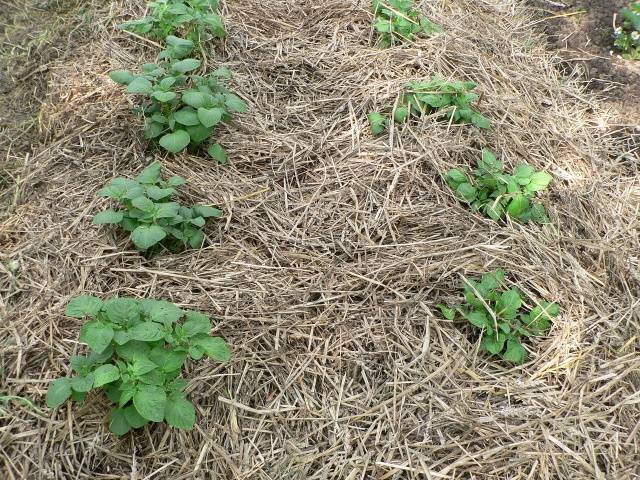

Care
Speaking of leaving, everything is standard here. Potatoes love watering, fertilization, hilling and protection from diseases and parasites.
Speaking of watering, experienced gardeners recommend watering potatoes no more than three times, during certain periods of the growing season. The first time when sprouts appear, when they crawl out 5-6 cm. The second time, when the potatoes enter the flowering phase, and the third time, when they come out of it. Watering the crop after flowering is not recommended, as there is a great risk of catching late blight.
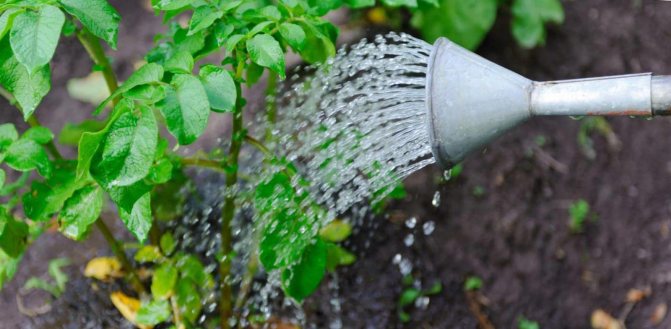

Potatoes are also responsive to feeding. Especially if they were carried out in the autumn. After harvesting, the site is dug up and fertilized with manure or compost. More, in general, Uladar does not need to be fed. Autumn fertilizers will be enough with your head.
Hilling is carried out as the tops grow. During the season, you need to spud the culture twice. The first time, when the tops reached 15-25 cm, the second, 2-3 weeks after the first hilling. During hilling, it is necessary not only to huddle the potatoes with soil, but also to clear the site of weeds that inhibit the development of tubers.
Naturally, if the culture encountered the Colorado potato beetle, it is necessary to carry out treatment with special insecticides. With diseases, everything is the same, only fungicides are used.
Fertilizers
You can support the fruitful potential of potatoes by applying fertilizers to the site in autumn, early spring, or by feeding the crop itself.
Site preparation
The area for potatoes has been prepared since autumn. Not having time to feed the site in the fall, you can provide the Uladar early potato variety with the necessary substances before planting. Choose one of the options:
- Organic fertilizers will enrich the soil and serve as a guarantee of the harvest. The application rates for fresh manure differ for different soil types. On heavy soils, 30 kg of organic matter per 1 sq. m, sandy ones require 40-60 kg. If humus is used, take a third of the above volumes;
- Superphosphate and potassium sulfate are also added to organics;
- In early spring, during the first cultivation of the soil, mineral preparations are scattered on the ground, then they are embedded in depth: 2 kg of potassium sulfate and 1 kg of double superphosphate are added per hundred square meters;
- Also fertilized with a phosphorite type of nitrophoska. In sandy and soddy-podzolic soils, nitrophosphate of the sulfuric acid type is introduced.
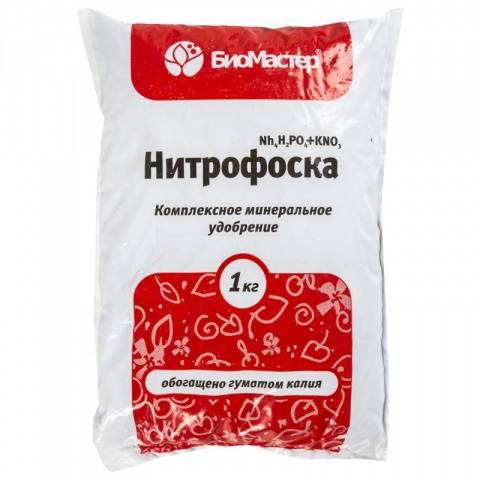

Plant feeding
There are many different ways to fertilize potatoes during the growing season.
- When planting early Uladar potatoes, they put 0.5-1 liters of humus, a handful of wood ash in the hole, and on heavy soils, add a handful of sand. The soil will become looser, it will be convenient for the tubers to grow in such soil. In addition, the sand will protect the potatoes from the wireworm to some extent;
- A month after planting the Uladar potato variety, 20 g of superphosphate, 10 g of potassium salt and urea are added to each square meter;
- On low shoots and in the phase of bud formation, potatoes are fed on a leaf with superphosphate. First, 3 tablespoons of granules are dissolved in 0.5 liters of boiling water. After a day, 0.3 liters of extracts are mixed with 10 liters of water and the plantings are sprayed;
- During flowering, fertilize with urea, also by foliar feeding: 50 g of the product are diluted in 10 liters of water. Consumption rate - 3 liters per 10 sq. m;
- After flowering, they are fed with magnesium and boron - the drug "Mag-Bor". Dilute 20 g in a bucket of water. Fertilizer improves the taste of any potato, including Uladar;
- Good results and easy application for ready-made products - "Impulse Plus", "Surprise", "Ideal", humates.
A warning! Do not mix dolomite flour and ammonium sulfate, as well as urea and superphosphate.
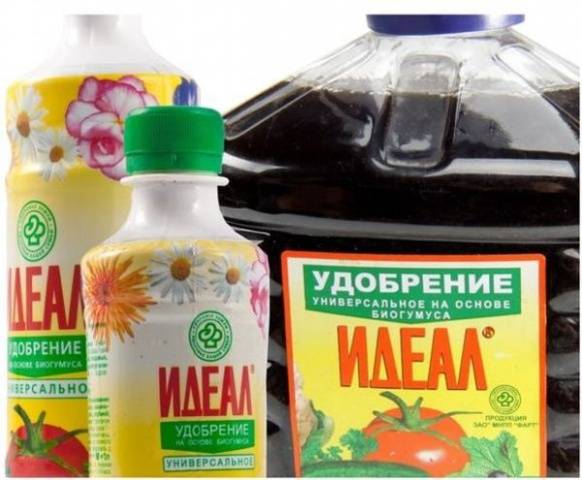

Growing
Before planting, the potatoes are first germinated. To do this, first the prepared tubers are washed with water. Then they are left in a dry, dark place at a temperature of 13–16 ˚С. After 2–2.5 weeks, as soon as the shoots appear, start planting.
Potatoes are planted in soil pre-fertilized with compost, the temperature of which is approximately 11 ˚С.
The main rule of a good harvest: this potato variety needs regular and frequent fertilization with minerals. Following this rule leads to an increase in the number of fruits in each bush.
The planting process involves digging holes of the correct depth within 5-9 centimeters. The minimum distance between them is 30–35 centimeters. If the ground is too dry, the pits deepen by 8-10 centimeters. Previously prepared and germinated tubers are planted sprouts upwards, then sprinkled with compost-fertilized soil.

